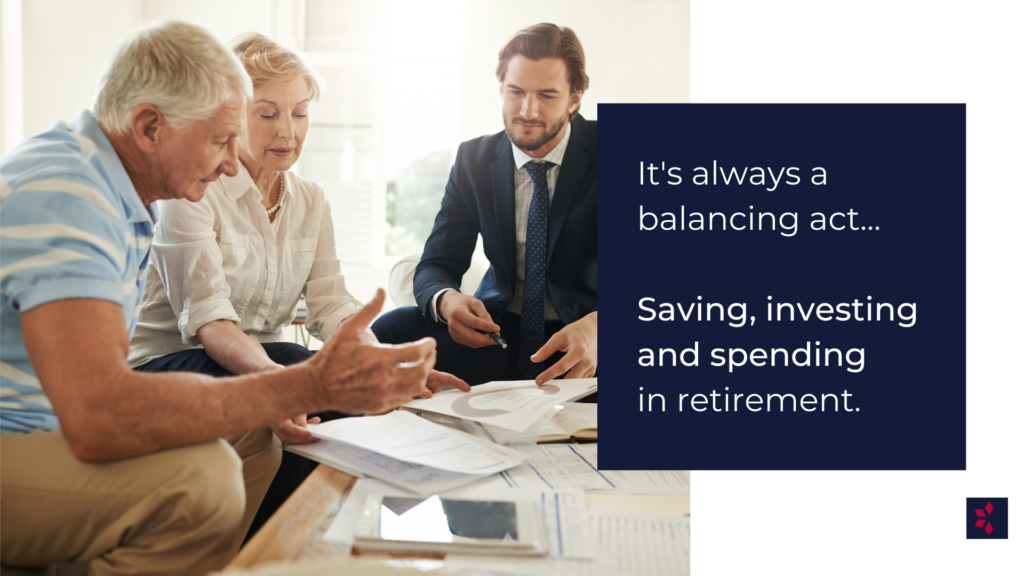It’s Always A Balancing Act…Saving, Investing And Spending In Retirement

When you retire from full-time work, whether as an employee or running your own business, you will face one of the most significant transitions in your lifetime. The road ahead becomes a balancing act, in which you must fund your desired lifestyle from a combination of your savings, investments and pensions. At the same time, you may wish to preserve some of your wealth to allocate to passion projects, personally important causes and future generations.
Here we highlight tips to help you ensure that your wealth allocations in retirement are balanced and sustainable. We also provide a bonus example to showcase how a shift in retirement investments does not have to come at the expense of wealth accumulation.
What To Consider In Your Retirement Plan
The importance of a financial plan cannot be overstated, particularly when it comes to retirement planning. To be able to make effective allocations of your wealth, you must first have a clear and full understanding of all your future expenses, with reasonable estimates where exact amounts are not yet known. Be sure to take inflation into account as your retirement time horizon may very well extend for decades, so your monthly costs can and likely will increase over time due to inflation.
You should also give thought to future medical expenses, such as treatments not covered by OHIP or long-term care costs, that may not be relevant at the outset of retirement but may very well become important later on. Such costs could derail your retirement if not accounted for in the planning stage. Along with researching the costs behind such services, you may also wish to consider your family history, both in terms of longevity and medical events, to guide your assumptions around life expectancy and long-term budgeting.
Be Mindful Of Tax Brackets In Retirement
As you enjoy your retirement lifestyle, it is important to remember that your cash flow, along with various types of income provided by investments, business interests and pensions, will in most cases be subject to tax and will together form your taxable income.
In Canada, we are subject to a system of graduated tax rates, combining Federal rates with those at the provincial level, so that as your taxable income grows, dollars earned in each bracket will be taxed at progressively higher rates, meaning that your tax liability will grow comparatively more onerous as your taxable income increases. Investment income is taxed differently depending on the type of income, with capital gains currently only subject to a 50% inclusion rate, interest income being fully taxable, and eligible dividend income landing somewhere in the middle.
You can optimize your “take home” income from these various sources by being mindful of your current marginal tax brackets along with the differences in how income types are taxed. For instance, given that we pay personal taxes at the individual level rather than at the household level, you might be able to reduce your household’s overall tax bill by income splitting with a spouse in a lower tax bracket.
As well, RRSPs may have played a significant role in your accumulation of wealth for retirement; however, the income drawn out from an RRSP (or, following conversion, a RRIF) is fully taxable, so great care should be taken in the lead up to retirement to ensure that income from these sources will not add to other income and result in diminished tax efficiency overall.
Ensure Your Retirement Investments Are Appropriate
During wealth accumulation, investors often adopt a more growth-oriented style, perhaps accepting greater volatility, and in some cases little to no income, given their relatively long investment horizon. However, investment objectives often shift in retirement—with the ongoing need for cash flow becoming a priority, often combined with a reduced threshold for volatility.
As you rebuild your taxable account portfolio to be more aligned with these changing needs, you can trigger large capital gains with corresponding pending tax liabilities. However, delaying this important step may be detrimental to the alignment of your investments and your future needs. Inaction may even reduce your retirement’s sustainability in the event of a market pullback since your time horizon and other new objectives may not be as conducive to patient buy-and-hold investing as before.
To remedy this, you may wish to begin early, gradually transforming your portfolio to align with your retirement objectives. If you do this in the years leading up to retirement, you may be able to take advantage of the extra time to both manage the volatility of your growth-oriented investments and to spread the triggering of capital gains over several years, reducing tax on your overall wealth.
It is important to also remember that a portfolio with an attractive income yield, such as one comprised of dividend-paying stocks and real estate investment trusts (REITs), can provide meaningful capital appreciation as well as income —a total return approach. The key takeaway is that you can adjust your investment strategy into one that not only supports retirement, but also continues to accumulate wealth, allowing you to “have your cake and eat it.”
This content is provided for general informational purposes only and does not constitute financial, investment, tax, legal or accounting advice nor does it constitute an offer or solicitation to buy or sell any securities referred to. Individual circumstances and current events are critical to sound investment planning; anyone wishing to act on this content should consult with his or her financial partner or advisor.